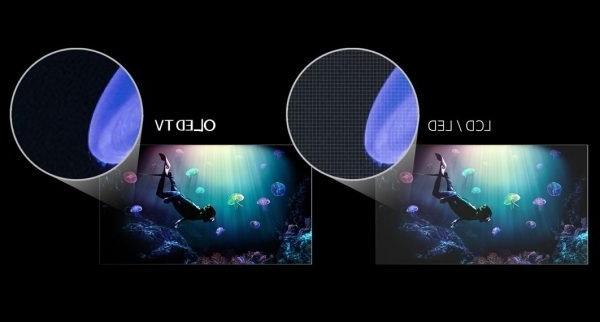A few months ago we talked about 4K TVs, shedding light on the visual experience of HDR video content. Today we examine the main technologies related to Ultra HD television panels, trying to deepen some notions, beyond the acronyms that continually pass under our eyes, and the configurations that most interest players. Let's start from the basic concepts of a liquid crystal display, or LCD (Liquid Crystal Display), the model that started the era of flat screen TVs and scrapped bulky cathode ray tube (CRT) televisions, to get to the most interesting implementations today, analyzing differences, advantages and disadvantages.
LCD: from fluorescent lamps to LEDs
An LCD panel is mainly composed of a matrix of microunits, better known as pixels, which are responsible for projecting images. These are divided into three microcells, blue, red and green (the three primary colors that make up the abbreviation RGB) which, when combined with each other, are able to emit millions of variants.
A fundamental aspect of LCD technology, as well as a source of numerous limitations, is related to the fact that the pixels do not emit light autonomously, but need a backlight system. The first generation of LCD TVs used a cold cathode fluorescent lamp panel, or CCFL, for this purpose. The overall yield of the first expensive models was far from optimal, in some ways inferior to cathode ray tube TVs, also due to the lack of adequate sources for this technology.
The first problem with a backlight system is the image contrast. The surface behind it is in fact always on and in the last article we learned that the main enemies of image contrast are the sources of external lights, right?
A first qualitative leap took place about ten years ago when the first Full HD models with LED backlighting (LCD / LED) were introduced, which today has completely replaced the CCFL solution. The LED systems, in the face of lower costs and consumption, guaranteed better contrast thanks to a more uniform lighting and faithful to the level of white.
Motion Blur, Ghosting e Input Lag
But the real problems for those who play on the LCD relate to moving images. The wake effect, better known as motion blur, is the most common and annoying phenomenon that occurs when images change rapidly. This is a defect linked to the chromatic variation speed of the individual pixels and at the moment it cannot be completely mitigated. In these situations the animation is blurred, with less detail and presents, as the name implies, a trail that starts from the position of the moving object in the previous instant. Motion blur is often combined with another unwelcome image-splitting effect, called ghosting. It should be noted that, in some cases, the cause of these phenomena may depend on the service provided, the lack or loss of frames, especially in streaming or during online sessions, as well as external peripherals such as receivers with activated synchronization systems such as the lip-sync.
The response times of the image projected on the screen, not to be confused with the aforementioned response times of the pixel color conversion, determine another factor well known to gamers, namely the input lag. In other words, it is a delay in the on-screen image processed as a result of an input, such as a key press or movement on the analog stick of the joypad.
This latency phenomenon, which afflicts reactivity during a gaming session, only took on considerable weight with the introduction of LCD screens, given that the old CRTs had, at worst, a delay of around 8 milliseconds. An enviable figure even for today's top performing TVs.
Of course, over the years, hi-tech manufacturers have introduced numerous solutions to push the visual qualities of LCD televisions and remedy their defects.
Edge LED, Full Led and other mid-range solutions
The first LCD / LEDs on the market brought with them some image interpolation systems to attenuate motion blur. Thanks to frame rates of 100 / 200Hz it was in fact possible to act on the fluidity of the animation, but at the risk of an excess of fluidity that made the movements unnatural, giving, among others, the dreaded "soap opera" effect. Fortunately, on modern LCD TVs, even the cheapest ones, it is possible to work on the settings to find the right compromise between fluidity and realism.
To solve the problem of input lag, on many models there is the "gaming mode", an image processing system suitably designed to lower the response times of the input data. This mode is also available starting from the low end of the market and it is possible to go below 30 milliseconds, an absolutely acceptable threshold value.
Of course, starting from the mid-range things get more interesting both in terms of animations, colors and contrast. Like the LCD / Edge LED TV models, where the backlight is placed around the perimeter of the screen and the light is evenly projected onto the screen. The panels gain in brightness and contrast and are particularly suitable for HDR signals.
The successors of the Edge LED TVs are the Full Array LED panels, where a series of LEDs extended over the entire liquid crystal screen, acts with greater accuracy on specific areas of the screen. This configuration is particularly suitable for local dimming technology (already discussed in the previous article) and guarantees brighter colors and a higher contrast than the Edge LEDs.
Sony has also introduced proprietary technologies Triluminos and Motionflow XR which act respectively on color management and animations.
In addition to the improvement systems described above, the LED structure has undergone an evolutionary leap in recent years thanks to OLED and QLED technologies.
OLED and organic-structured pixels
Made by the Korean giant LG, the OLED (Organic LED) technology offers pixel screens of organic nature, carbon to be precise, able to light up autonomously when powered by electricity, completely eliminating the backlight and the consequent limitations. The qualitative leap is notable and can be clearly seen in all the main aspects. A self-illuminating pixel, ensures more natural colors, thrilling contrasts, and faster color changes by enhancing animations. The lack of accessory devices to provide light also improves latency, and input lag always drops below 30 milliseconds. Anticipating the final conclusions a little, let's say that if a player wants to play it safe without too many compromises he should aim for this type of solution.
The most important and heralded aspect is the so-called infinite contrast, which deserves further study, given that it is often flaunted by the average user without actually knowing what it is, that is the simple result of a mathematical calculation. But let's go in order.

First of all, the contrast ratio, we have already talked about in the last article, is the ratio (in fact) between the measurement of the lightest and darkest image, both expressed in candelas (cd). The organic pixels, being autonomous, in the presence of blacks go out giving rise to the so-called absolute black, therefore a luminous intensity equal to 0 cd. Infinity, or rather, tending towards infinity, is nothing other than the result of this division. But if math is not an opinion, the same cannot be said for visual perception. Also because, if you want to be picky, absolute black does not exist in a real situation, as long as you are in a perfectly dark environment and want to entertain yourself with a 100% black image.
In any case, it is easy to understand, OLEDs give their best and stand out from the competition in less lighted environments. As for the signals HDR, these panels comply with the UHD Alliance standard 2, designed specifically for less bright screens where the black and white levels are calibrated downwards.
Personally I believe that, with the introduction of OLEDs, the term "contrast ratio" is destined to end up in oblivion and hi-tech manufacturers will have to invent some other effective term for marketing.
This does not detract from the unique quality offered by the absolute blacks of an OLED. Unique because it cannot be found with other backlight technologies where the dark areas always tend to be a little gray. Games where darkness will be a primary element of the experience will benefit, such as survival horror or gothic action / action RPGs like Bloodborne.
We come to the defects. First of all the costs, given that at the moment an OLED hardly falls below 1000 euros.
The organic material, as known, is subject to a greater deterioration compared to synthetic solutions, to the detriment of the longevity of the product. Following this process of pixel deterioration, the competition also speaks of a decline in performance as time progresses, particularly in the blue color.
OLEDs also have the problem of image retention, which is an overlay of previous images. This is especially noticeable with images that remain fixed for a long time, such as HUDs or game interfaces.
Instead, we speak of burn-in when the retention is permanent. This is a rare phenomenon with extremely long use of the TV. But, mind you, it is a real problem and is not covered by the warranty.
In any case, OLED manufacturers have today introduced automatic refreshing systems, such as the Pixel Refresher, which make the two phenomena even more sporadic.
QLED: evolution or revolution?
QLED (Quantum Dot LED) are televisions based on Quantum Dot technology made by Samsung. These are backlit panels, but behind the liquid crystal screen resides a thin film composed of nanocrystals, or quantum dots, which specifically filter the emitted light. Given the extremely small size of the quantum dots, the filtered light is able to enhance the chromatic nuances and contrasts with a precision unattainable with normal LCDs. The real strength of QLED technology is its brilliance, which allows TVs based on this technology to make the most of HDR video signals. The blacks are deep, while never reaching the absolute black of an OLED. QLED televisions, reserved for the medium and high segments of the TV market, arrived on the market at exorbitant prices, but today they can be purchased at a lower cost, especially the mid-range ones that at certain times of the year can fall well below. of the 1000 euros and cost a little more than a good entry-level not discounted.

It is evident that the introduction of the QLED has raised the qualitative yield of LED technology, but we cannot speak of a real revolution as in the case of OLED rivals. But the real evolutionary leap according to Samsung is already upon us. The much discussed hybrid OLED-QLED system is a reality after the announcement of the MicroLED technology which seems to combine the strengths of the two antagonistic solutions. We will know more about this at the next CES in Las Vegas, scheduled as every year in January. Probably the first MicroLED implementations will be aimed at the next 8K generation.
What is the best choice?
As already mentioned above, net of the expense and some defects, an OLED TV is certainly the best choice to make, especially for those aiming at the high / medium-high range or if the new TV needs to replace an early generation 4K.
For the vast majority of users coming from a low-end Full HD TV, further consideration is in order. Some industry experts say that, in a normal home environment, to better appreciate the absolute blacks of an OLED compared to the deep blacks of a QLED or a mid-range LCD / LED (with excellent management of local dimming), a perception is necessary. trained visual.
It is therefore worth asking whether any tangible differences are worth an investment of 5/600 euros or not, almost doubling the expense. At the moment, in fact, there are 55-inch QLED models on the market for less than 700 euros.
From my point of view, the essential choices are mainly linked to HDR (see previous article) and input lag, therefore to those devices equipped with the “game mode” option or latency values below 30 milliseconds. For the visual quality it is necessary to deal with one's availability, but I renew my advice to invest in a mid-range product. In the next article we will try to examine some models, from the cheapest to the high-end ones.
Videogamingallday.com Help Did you like the article? Share it!

























